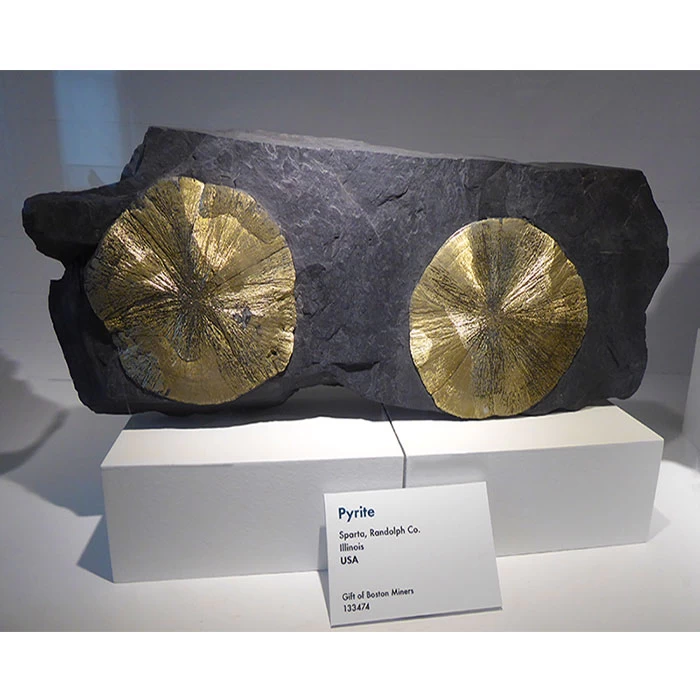Pyrite: Properties, Facts and Photos

| Contents 1. What is Pyrite? 2. Pyrite Properties (geology) 3. Meaning of Pyrite 4. Article Pictures 5. Shop for Pyrite |
What is Pyrite?
Pyrite, also known as iron pyrite and fool's gold, is an iron sulphide mineral, meaning it's a chemical compound of iron and sulphur.
Its chemical formula, FeS₂, indicates that each pyrite molecule contains one iron atom and two sulphur atoms bonded together, which gives pyrite its metallic lustre and golden appearance.
Although pyrite can look similar to gold, several characteristics make it relatively easy to tell one from the other.
One of the most noticeable differences is colour because pyrite is not as yellow. It also weighs less than gold and is much harder.
Gold is very soft and grades just 2 to 2.5 on the Mohs scale, about the same as a fingernail. Pyrite is 6 to 6.5, but it's also brittle.
If you strike a piece of gold, it will flatten. Do the same to pyrite and it will break into many pieces.
Pyrite and gold have a different crystal structure and different coloured streak. Streak is the colour of a mineral in powdered form. In pyrite, the streak is greenish-black, and in gold, it's golden or yellow.
The name fool's gold is often associated with the Great American Gold Rush because small pieces of pyrite were said to have been mistaken for gold. Although the name may have been used during the Gold Rush, it can be traced back much further.
You can read more about the name fool's gold in this online book about the mineral pyrite. The article begins on page 6, which you can jump to from the contents page. I wasn't able to link to it directly. The book is here. It's a little slow to download, but makes an interesting read.
In pirate films, when they found treasure, they would often bite into a coin to confirm it was gold. This almost certainly came out of Hollywood. Biting into pure gold may well leave teeth marks due to its softness, but biting a coin from this period would not have the same effect. That's because coins were already being alloyed with another metal to improve hardness.
An example of this was seen during the 2024 Olympics when a Chinese gymnast saw fellow medalists biting on their gold medals. Although she didn't understand the reason for doing this, she did the same.
Properties of Pyrite (geology)
Pyrite contains a high percentage of iron and is relatively common, hence can be found in many geological environments.
Sulphide minerals are a class of minerals that consist of one or more metallic elements chemically bonded to sulphur. As well as iron, the element can be copper, lead, zinc, nickel, or silver.
Pyrite occurs in a variety of forms, making it particularly popular with rock and mineral collectors.
Pyrite crystals are often isometric (cube-shaped), which is one of the simplest and most common crystal shapes. They can also be octahedrons or pyritohedrons, (a pyritohedron).
Pyrite in a flat disc-like shape with outward radiating crystals is known as a pyrite sun. The crystal habit of pyrite can also be massive.
Pyrite's crystal faces can also be striated, another characteristic that distinguishes pyrite from gold.
In the late 1970s, deep-sea hydrothermal vents were discovered on the ocean floor at previously unexplored depths. These vents supported unique ecosystems with hundreds of newly discovered species. Many of the vents emitted mineral-rich fluids containing pyrite at temperatures as high as 400°C (752°F).

Gold and pyrite form under very similar geological conditions and even occur within the same rock. Inclusions of gold in pyrite are not uncommon.
Although pyrite could be used as an ore, it rarely is, because there are many other more suitable minerals from which gold can be extracted.
Pyrite is a relatively common mineral found worldwide but generally only occurs in small quantities.
The Rio Tinto region of Spain has vast pyrite reserves. Countries including Bolivia, Brazil, Peru, Japan, Canada and Italy, to name just a few, have produced many fine specimens of pyrite.

The Meaning of 'Pyrite'
The word 'pyrite' comes from the Greek 'pyr', meaning 'fire'. When struck with stone or steel, tiny pieces break away and react with oxygen, creating burning hot sparks. This was one of the earliest methods humans used to create fire.
The wheel-lock gun, developed around 1500, was ignited by spinning a spring-loaded steel wheel against a small piece of pyrite. This generated sparks, which ignited the gunpowder and the charge in the gun's barrel.
Article Pictures
Pictures 1 and 3 in our article were taken during visits to the Harvard Museum of Natural History and London's Natural History Museum.
Picture 2 is courtesy of Ron Wolf.
Both images are clickable and redirect to the original photo.
Pop-up photos: Copper and pyritohedron - Courtesy of Stan Celestian. Pyrite concretion - Courtesy of Ron Wolf.









